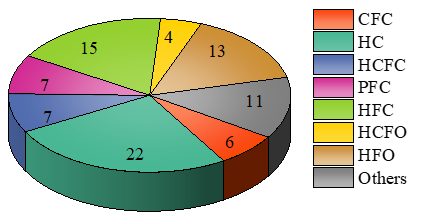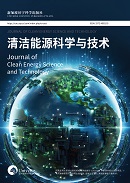基于量子化学的有机朗肯循环工质筛选策略研究
DOI:
https://doi.org/10.18686/cncest.v2i2.106关键词:
有机朗肯循环;工质筛选;热力学;量子化学摘要
工质筛选是研究有机朗肯循环发电系统的关键内容之一。由于工质的种类多、组分结构复杂,增大了工质筛选难度。本文从工质热力学物性角度入手,开展工质筛选策略研究,提出以对比理想气体热容判定因子为依据,定量判断工质的干湿特性。当判断因子>1时为干工质,当判断因子<1时为湿工质,23种工质的计算数据和文献数据的对比结果表明,该判断因子的计算结果具有可靠性。提炼出“三步法”初步筛选策略用于有机朗肯循环的工质筛选,该策略包含工质基础物性分析、干湿特性的研究、量子化学分析,该筛选策略从微观和宏观角度解释了有机朗肯循环系统工质筛选的机理,为有机朗肯循环工质的构效关系研究奠定基础。

##submission.downloads##
已出版
文章引用
期
栏目
执照
版权声明
CC BY-NC 4.0参考
1. 孙瑞强, 杨凯旋, 王博, 等. 超临界二氧化碳燃煤发电系统低温余热回收的技术经济性优化. 热力发电. 2020, 010: 049.
2. Sun R, Yang K, Wang B, et al. Technical and economic optimization of low-temperature waste heat recovery for supercritical carbon dioxide coal-fired power generation systems (Chinese). Thermal Power Generation. 2020; 010: 049.
3. 张诚. 低品位余热有机朗肯循环综合性能评估与实验研究 [博士学位论文]. 重庆大学; 2018.
4. Zhang C. Comprehensive Performance Evaluation and Experimental Study of Low-Grade Waste Heat Organic Rankine Cycle (Chinese) [PhD thesis]. Chongqing University; 2018.
5. Rowlands IH. The Fourth Meeting of the Parties to the Montreal Protocol: Report and Reflection. Environment: Science and Policy for Sustainable Development. 1993, 35(6): 25-34. doi: 10.1080/00139157.1993.9929109
6. Bao J, Zhao L. A review of working fluid and expander selections for organic Rankine cycle. Renewable and Sustainable nergy Reviews. 2013, 24: 325-342. doi: 10.1016/j.rser.2013.03.040
7. Martin TM, Young DM. Prediction of the Acute Toxicity (96-h LC50) of Organic Compounds to the Fathead Minnow (Pimephales promelas) Using a Group Contribution Method. Chemical Research in Toxicology. 2001, 14(10): 1378-1385. doi: 10.1021/tx0155045
8. Kondo S, Urano Y, Tokuhashi K, et al. Prediction of flammability of gases by using F-number analysis. Journal of Hazardous Materials. 2001, 82(2): 113-128. doi: 10.1016/s0304-3894(00)00358-7
9. Zhang X, Zhang Y, Wang J. New classification of dry and isentropic working fluids and a method used to determine their optimal or worst condensation temperature used in Organic Rankine Cycle. Energy. 2020, 201: 117722. doi: 10.1016/j.energy.2020.117722
10. Zhang T, Liu L, Hao J, et al. Correlation analysis based multi-parameter optimization of the organic Rankine cycle for medium- and high-temperature waste heat recovery. Applied Thermal Engineering. 2021, 188: 116626. doi: 10.1016/j.applthermaleng.2021.116626
11. Groniewsky A, Györke G, Imre AR. Description of wet-to-dry transition in model ORC working fluids. Applied Thermal Engineering. 2017, 125: 963-971. doi: 10.1016/j.applthermaleng.2017.07.074
12. Garrido JM, Quinteros-Lama H, Mejía A, et al. A rigorous approach for predicting the slope and curvature of the temperature–entropy saturation boundary of pure fluids. Energy. 2012, 45(1): 888-899. doi: 10.1016/j.energy.2012.06.073
13. Lukawski MZ, Tester JW, DiPippo R. Impact of molecular structure of working fluids on performance of organic Rankine cycles (ORCs). Sustainable Energy & Fuels. 2017, 1(5): 1098-1111. doi: 10.1039/c6se00064a
14. Wang J, Zhang J, Chen Z. Molecular Entropy, Thermal Efficiency, and Designing of Working Fluids for Organic Rankine Cycles. International Journal of Thermophysics. 2012, 33(6): 970-985. doi: 10.1007/s10765-012-1200-6
15. Stijepovic MZ, Linke P, Papadopoulos AI, et al. On the role of working fluid properties in Organic Rankine Cycle performance. Applied Thermal Engineering. 2012, 36: 406-413. doi: 10.1016/j.applthermaleng.2011.10.057
16. Palma-Flores O, Flores-Tlacuahuac A, Canseco-Melchorb G. Simultaneous molecular and process design for waste heat recovery. Energy. 2016, 99: 32-47. doi: 10.1016/j.energy.2016.01.024
17. Papadopoulos AI, Stijepovic M, Linke P. On the systematic design and selection of optimal working fluids for Organic Rankine Cycles. Applied Thermal Engineering. 2010, 30(6-7): 760-769. doi: 10.1016/j.applthermaleng.2009.12.006
18. Ingman VM, Schaefer AJ, Andreola LR, et al. QChASM: Quantum chemistry automation and structure manipulation. WIREs Computational Molecular Science. 2020, 11(4). doi: 10.1002/wcms.1510
19. Bogojeski M, Vogt-Maranto L, Tuckerman ME, et al. Quantum chemical accuracy from density functional approximations via machine learning. Nature Communications. 2020, 11(1). doi: 10.1038/s41467-020-19093-1
20. Needham CD, Westmoreland PR. Combustion and flammability chemistry for the refrigerant HFO-1234yf (2,3,3,3-tetrafluroropropene). Combustion and Flame. 2017, 184: 176-185. doi: 10.1016/j.combustflame.2017.06.004
21. Chen H, Goswami DY, Stefanakos EK. A review of thermodynamic cycles and working fluids for the conversion of low-grade heat. Renewable and Sustainable Energy Reviews. 2010, 14(9): 3059-3067. doi: 10.1016/j.rser.2010.07.006
22. Liu BT, Chien KH, Wang CC. Effect of working fluids on organic Rankine cycle for waste heat recovery. Energy. 2004, 29(8): 1207-1217. doi: 10.1016/j.energy.2004.01.004
23. Poling BE, Prausnitz JM, O’Connell JP. Properties of Gases and Liquids, 5th ed. McGraw-Hill Education; 2001.
24. Linderberg J, Öhrn Y, Brändas EJ, et al. Per-Olov Löwdin. Löwdin Volume. Published online 2017: 1-7. doi: 10.1016/bs.aiq.2016.04.001
25. Boeyens JCA. Quantum Chemistry. The Theories of Chemistry. Published online 2003: 261-332. doi: 10.1016/b978-044451491-2/50018-7
26. Tu W, Bai L, Zeng S, et al. An ionic fragments contribution-COSMO method to predict the surface charge density profiles of ionic liquids. Journal of Molecular Liquids. 2019, 282: 292-302. doi: 10.1016/j.molliq.2019.03.004
27. Grensemann H, Gmehling J. Performance of a Conductor-Like Screening Model for Real Solvents Model in Comparison to Classical Group Contribution Methods. Industrial & Engineering Chemistry Research. 2005, 44(5): 1610-1624. doi: 10.1021/ie049139z
28. Johnson ER, Keinan S, Mori-Sánchez P, et al. Revealing Noncovalent Interactions. Journal of the American Chemical Society. 2010, 132(18): 6498-6506. doi: 10.1021/ja100936w
29. Lu T, Chen F. Multiwfn: A multifunctional wavefunction analyzer. Journal of Computational Chemistry. 2011, 33(5): 580-592. doi: 10.1002/jcc.22885
30. Wu W, Yang Y, Wang B, et al. The effect of the degree of substitution on the solubility of cellulose acetoacetates in water: A molecular dynamics simulation and density functional theory study. Carbohydrate Research. 2020, 496: 108134. doi: 10.1016/j.carres.2020.108134
31. Lukawski MZ, DiPippo R, Tester JW. Molecular property methods for assessing efficiency of organic Rankine cycles. Energy. 2018, 142: 108-120. doi: 10.1016/j.energy.2017.09.140
32. Emamian S, Lu T, Kruse H, et al. Exploring Nature and Predicting Strength of Hydrogen Bonds: A Correlation Analysis Between Atoms‐in‐Molecules Descriptors, Binding Energies, and Energy Components of Symmetry‐Adapted Perturbation Theory. Journal of Computational Chemistry. 2019, 40(32): 2868-2881. doi: 10.1002/jcc.26068
33. Li G, Gui C, Dai C, et al. Molecular Insights into SO2 Absorption by [EMIM][Cl]-Based Deep Eutectic Solvents. ACS Sustainable Chemistry & Engineering. 2021, 9(41): 13831-13841. doi: 10.1021/acssuschemeng.1c04639
34. Klamt A. COSMO-RS: From Quantum Chemistry to Fluid Phase Thermodynamics and Drug Design. Elsevier; 2005.
35. AL-Arfi I, Shboul B, Poggio D, et al. Thermo-economic and design analysis of a solar thermal power combined with anaerobic biogas for the air gap membrane distillation process. Energy Conversion and Management. 2022; 257: 115407. doi: 10.1016/j.enconman.2022.115407




